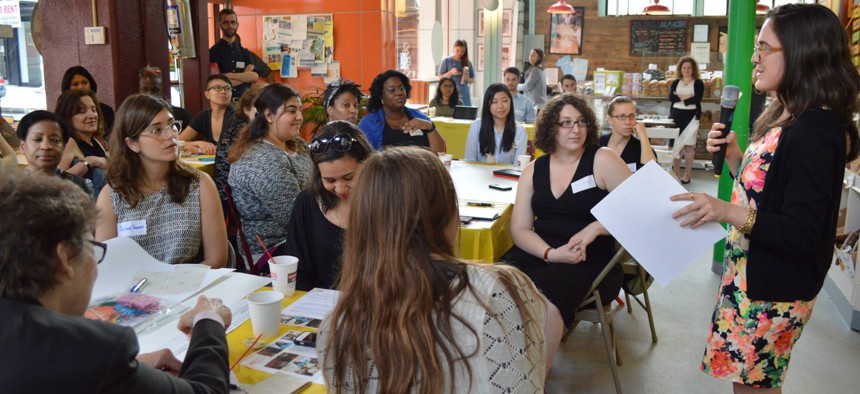New York City Looks to Close Gender Gap in Business Ownership

Courtesy New York City Department of Small Business Services

Connecting state and local government leaders
With WE NYC, officials hope to “uplift entire families, communities and our city’s economy.”
Months ago, New York City’s government asked a specific subset of business owners to come out and tell their tales and assist them in business: women.
Their efforts were part of WE NYC, an initiative launched by the city to help women with their businesses. The program was launched in March and program leaders are gearing up to release a report on International Women’s Day.
“Women’s entrepreneurship is an issue I care deeply about as a woman in the economic development field, a public servant, a mother, and a New Yorker,” said Alicia Glen, deputy mayor for New York City for economic development and housing, in an emailed statement. “We know there is an unacceptable gender gap when it comes to the number and success of women-owned businesses in our city. With the launch of WE NYC, we will introduce services that help women entrepreneurs thrive—because, when we uplift women business owners, we uplift entire families, communities and our city’s economy.”
Rachel Van Tosh, New York City’s assistant commissioner for business development, said that $50 billion in revenue comes from female entrepreneurs annually, and that 200,000 people are employed in the city as a result of female entrepreneurs. According to a preliminary report by WE NYC, there are 359,000 businesses in the city owned by women entrepreneurs.
But even so, there’s a “gender gap,” she said.
“Men own one and a half times more businesses,” Van Tosh said. “They employ three and a half times more women and make on average four and a half times more revenue. So we really started this to address that gender gap by offering services tailored to the needs of women entrepreneurs especially women in underserved communities.”
Van Tosh said throughout holding these various forums, the city contacted more than 350 women.
“During the whole thing . . . we spoke with more than 350 women across those community forums,” Van Tosh said. “We also conducted a few interactive focus groups with women totally in Spanish.”
Van Tosh said she was surprised by women’s reaction to both the role of government and how they could help each other.
“I would say what surprised me most in some ways really was I thought inspiring . . . women saw government as such a proactive partner at these forums in a way that I’d never seen in community outreach before,” Van Tosh said. “They really bought into the idea and contributed in a way that we were building solutions together.”
She continued: “I was also really struck with how honest women were about all the different types of challenges they face. And while they were talking about these challenges that they were so willing to support each other and they were constantly recommending different resources and giving each other helpful advice.”
What’s the goal of the program? It’s to work with 5,000 women in three years, according to the program’s website. The city said it wants to do that through “free business courses and financing assistance.”
Two of the main goals for WE NYC are “increasing income stability for women and families by supporting entrepreneurship as an opportunity” for them to make money and “facilitating the growth of their companies to increase investment and create jobs in New York City” by helping build up women’s “economic impact,” according to findings in WE NYC’s preliminary report, which also notes that women have obstacles in their way to have their own businesses.
They have “less access to capital than men, less training and education, fewer support systems and latent discrimination that can hamper their success,” the report states.
The city held forums in all five boroughs this past spring. Women had a place to network, help build services for them to use, showcase their own experiences and “connect to free business resources” according to an Eventbrite listing for the events.

The cost of the program has been in the form of staff time, VanTosh said. As for venues, one of the places the city held a forum was at a public library, she said.
“Now we’re able to integrate this community engagement and co-creation model in other initiatives throughout the agency which we have done since we launched WE NYC,” she said. “I think that any government—local, state, small, large—would be able to do this.”
Some of the skills they had to teach their staff were how to facilitate, and “how to manage a conversation around the table,” she said. “Engage people who are maybe less engaged.”
Women have also been receptive to the program, VanTosh said, and they’ve “had wait lists when we have info sessions that we promoted” and that their emails have had high open rates.
“Women in our WE NYC network . . . are very willing to volunteer their ideas and time through continued focus groups and feedback forums,” she said.
One of the women involved in the program is Regina Fleming, who runs a photography business in Harlem. Fleming went to a focus group for WE NYC.
“The city is looking to give us a say,” she said. “This is something that’s exciting.”
(Photo by littleny / Shutterstock.com)
Allison Prang is a journalist based in Charleston, South Carolina, and is a reporter for The Post and Courier.

NEXT STORY: White House Pushes Back Against Governors’ Calls to Block Refugees




